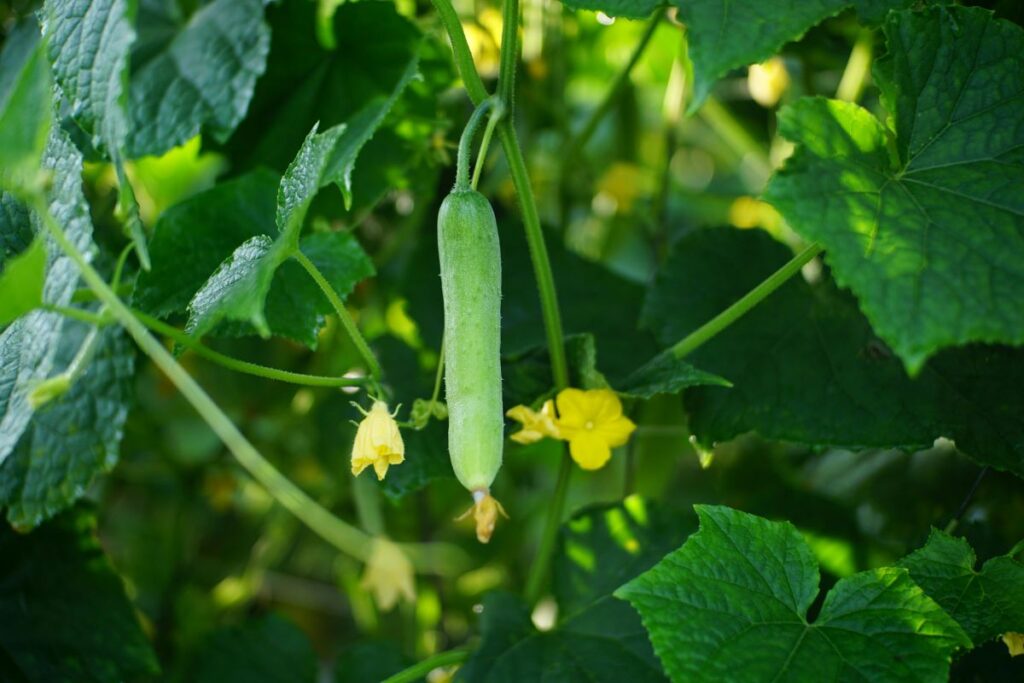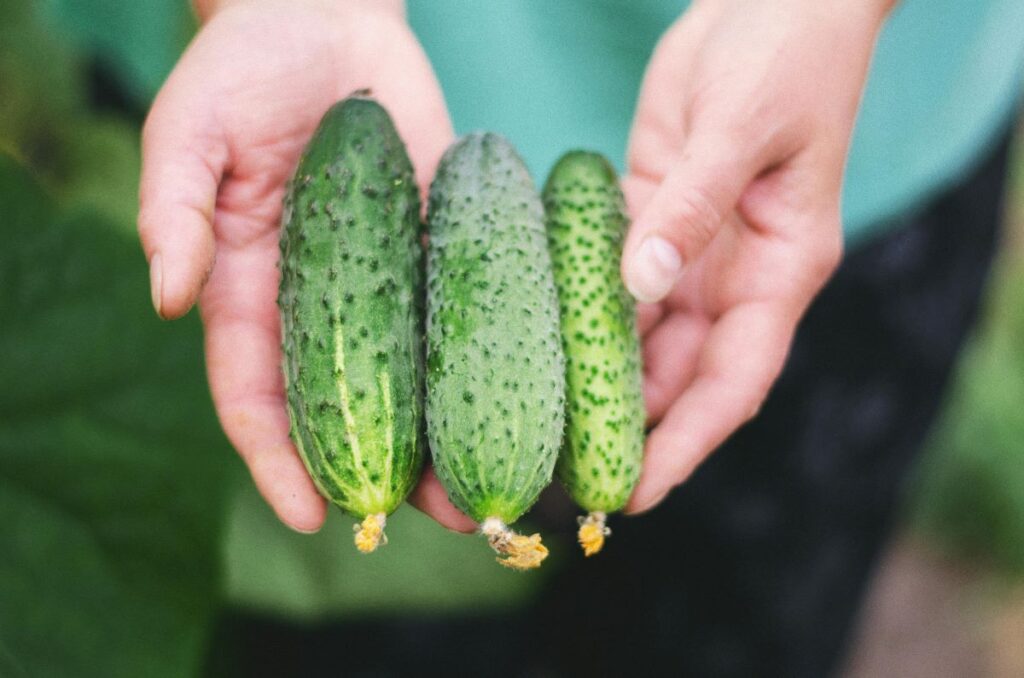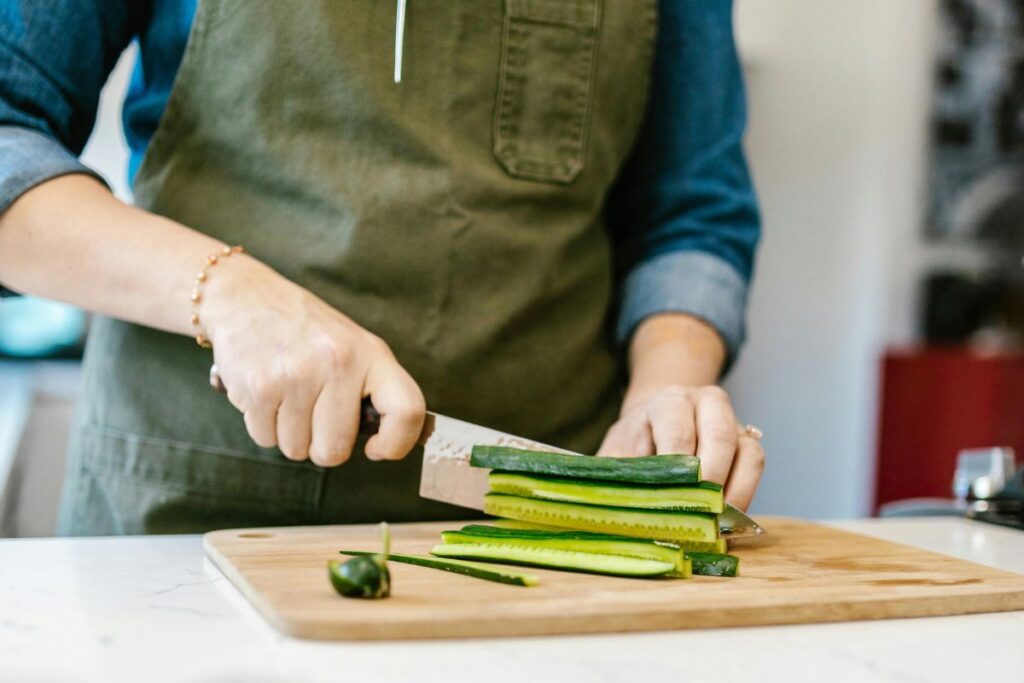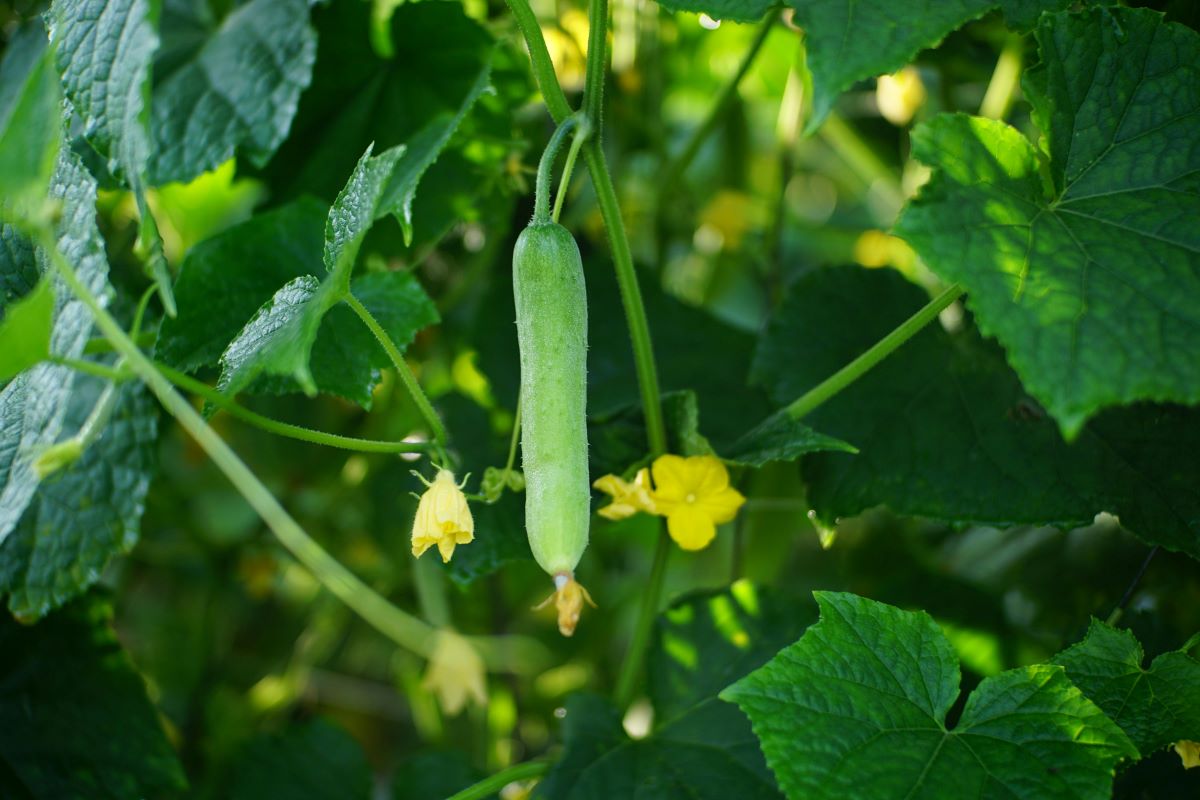Have you ever sliced a cucumber into your salad and wondered, “Wait, is this a fruit or a vegetable?” Don’t worry, you’re not alone. Most of us grew up thinking cucumbers belong to the vegetable family. But then someone in science class throws a twist and says it’s a fruit. Confusing, right?
Well, today we’re clearing it all up. We’re going to answer the question: Is cucumber a fruit? We’ll go deep into the science, toss in a few fun facts, and even explain it in ways that just make sense in daily life. By the end of this post, you’ll not only know the answer—you’ll remember it every time you reach for a cucumber.
Table of Contents
What Really Makes Something a Fruit?
Let’s start simple. What exactly is a fruit anyway?
Scientists have a clear answer for this. A fruit is any part of a plant that grows from a flower. It also needs to contain seeds. That’s it. Those are the only two rules that matter.
Think about it this way. The flower is like the plant’s baby-making station. When that flower gets pollinated, it starts growing into a fruit. The fruit’s main job is to protect the seeds inside. Then, when the time is right, those seeds can grow into new plants.
So here’s what this means:
- Apples are fruits because they come from flowers and have seeds
- Oranges are fruits for the same reason
- Bananas are fruits too (yes, they have tiny seeds!)
- Even nuts are technically fruits
But wait. There’s more. This definition might surprise you:
Unbelievable, right? But it gets even more interesting when we talk about cucumbers.
The Simple Truth About Cucumbers

Here comes the big reveal. Cucumbers are absolutely, definitely, 100% fruits!
Why? Let’s check our fruit rules:
- Do cucumbers grow from flowers? Yes!
- Do cucumbers contain seeds? Yes!
Case closed. Cucumbers pass the fruit test with flying colors.
If you’ve ever grown cucumbers, you’ve seen this happen. First, you get beautiful yellow flowers on your cucumber plant. Then, after pollination, those flowers start growing into cucumbers. Inside each cucumber, you’ll find plenty of seeds. Some are big. Some are small. But they’re definitely there.
Actually, cucumbers belong to the same plant family as melons and squash. This family is called Cucurbitaceae. All members of this family are fruits. So cucumbers are basically cousins to watermelons and pumpkins!
Why Everyone Gets Confused

Now you might be wondering: “If cucumbers are fruits, why does everyone call them vegetables?”
Great question! The answer lies in how we use food versus what it actually is.
In botany (the science of plants), we classify things by their structure. But in cooking, we classify things by taste and use. These two systems don’t always match up.
Here’s how most people think about food:
- Fruits are sweet or tart
- Fruits are eaten as snacks or desserts
- Vegetables are savory or bland
- Vegetables go in main dishes and salads
Cucumbers fit the “vegetable” pattern perfectly. They’re not sweet. They’re crunchy and refreshing. We put them in salads and sandwiches. So naturally, our brains say “vegetable.”
But science says otherwise. And science is pretty stubborn about these things!
The Kitchen vs. The Lab
This brings us to an important point. There are actually two ways to classify food:
Botanical classification: What the plant actually is Culinary classification: How we use it in cooking
Both are correct in their own way. In the lab, cucumbers are fruits. In the kitchen, they act like vegetables. Neither way is wrong!
Think of it like this. You might wear a suit to work and gym clothes to exercise. You’re the same person, but you dress differently for different situations. Cucumbers are the same way. They’re fruits that dress up like vegetables in our kitchens.
Many chefs and cookbooks call cucumbers vegetables. That’s totally fine for cooking purposes. But if you’re talking to a scientist or taking a biology test, you’d better call them fruits!
Other Foods That Trick Us
Cucumbers aren’t alone in this confusion. Lots of foods trick us the same way.
Here are some other “vegetables” that are actually fruits:
- Tomatoes: The most famous example. Even the Supreme Court got involved in this debate back in 1893!
- Bell peppers: All colors – red, yellow, green, orange
- Hot peppers: From mild jalapeños to super-hot ghost peppers
- Zucchini and summer squash: Surprise! They’re fruits too
- Eggplant: That purple beauty is definitely a fruit
- Avocados: Most people know this one by now
- Green beans: Yep, even these are fruits
All of these grow from flowers and contain seeds. So botanically, they’re all fruits. But culinarily, most people treat them as vegetables.
Meanwhile, some things we call fruits are actually vegetables:
- Rhubarb: It’s actually a stem, so it’s a vegetable
- Strawberries: Technically not true fruits (they’re “accessory fruits”)
Food classification can be really tricky!
Let’s Talk About Seeds
Since seeds are so important for fruit classification, let’s look closer at cucumber seeds.
Fresh cucumbers have soft, white seeds. They’re totally edible. In fact, they add a nice crunch to your salad. As cucumbers get older, the seeds get bigger and tougher. Some people remove them then, but they’re still perfectly fine to eat.
Different cucumber varieties have different amounts of seeds. English cucumbers (those long, skinny ones wrapped in plastic) have fewer seeds. They’re bred that way on purpose. But they still have seeds, so they’re still fruits.
Some cucumber varieties are grown specifically for their seeds. These seeds get roasted and eaten as snacks in many countries. Pretty cool, right?
The Pickle Plot Twist
Here’s a fun question: What about pickles?
Pickles are made from cucumbers. So what are they? Still fruits!
The pickling process doesn’t change what the cucumber actually is. It just changes how it tastes and feels. Whether it’s fresh, pickled, fermented, or cooked, a cucumber remains a fruit.
This might sound weird at first. Nobody thinks of pickles as fruits. But technically, that’s exactly what they are. Pickled fruits!
Next time you eat a pickle, you can impress your friends with this fact. You’re eating a fruit that’s been preserved in vinegar and spices.
Growing Your Own Fruit… Er, Cucumbers
Want to see the fruit process in action? Try growing cucumbers yourself!
Cucumbers are actually pretty easy to grow. Here’s what happens:
First, you plant seeds in good soil. Make sure they get plenty of sun and water. After a few weeks, you’ll see the cucumber plant start to grow. It will climb up stakes or spread along the ground.
Then comes the exciting part. Yellow flowers will appear on your plant. These flowers are where the magic happens. Some flowers are male, and some are female. Bees and other insects move pollen from male flowers to female flowers.
Once a female flower gets pollinated, it starts growing into a cucumber. You can actually watch this happen day by day. The tiny cucumber behind the flower gets bigger and bigger. In just a few weeks, you have a full-sized cucumber ready to pick.
And inside that cucumber? Seeds! The whole purpose of the cucumber is to protect and spread those seeds. That’s what makes it a fruit.
Health Benefits: Fruit or Vegetable, It’s Good for You
Whether you call it a fruit or vegetable, cucumbers are fantastic for your health.
Here’s what cucumbers bring to the table:
Hydration: Cucumbers are about 95% water. That makes them perfect for staying hydrated, especially in hot weather.
Low calories: A whole cucumber has only about 45 calories. You can eat as many as you want without worrying about weight gain.
Vitamins: Cucumbers contain vitamin K (good for bones) and vitamin C (good for immunity).
Minerals: They provide potassium, magnesium, and manganese.
Antioxidants: These help fight inflammation and protect your cells.
Fiber: The skin especially provides good fiber for digestion.
Skin benefits: Many people use cucumber slices on their eyes to reduce puffiness. The cooling effect feels amazing!
Plus, cucumbers are incredibly refreshing. On a hot summer day, nothing beats the cool crunch of a fresh cucumber.
Fun Cucumber Facts That Will Amaze You
Ready for some amazing cucumber trivia?
Ancient history: People have been eating cucumbers for over 3,000 years. Ancient Egyptians loved them so much that they put them in tombs for the afterlife!
Variety galore: There are more than 100 different types of cucumbers. Some are short and round. Others are long and skinny. Some are yellow or white instead of green.
Fast growers: Cucumbers grow incredibly fast. From flower to full-sized fruit in just 2-3 weeks. That’s nature’s speed record!
Cooling power: The phrase “cool as a cucumber” is scientifically accurate. The inside of a cucumber can be up to 20 degrees cooler than the outside air.
Beauty treatment: Cucumbers have been used in beauty treatments for centuries. Cleopatra supposedly used them to keep her skin young and fresh.
World records: The longest cucumber ever grown was over 3 feet long! The heaviest weighed more than 27 pounds.
Space food: NASA has studied growing cucumbers in space. They might be perfect for long space missions because they grow fast and provide water.
Different Ways to Enjoy Your Fruit

Now that you know cucumbers are fruits, maybe you want to try some new ways to eat them!
Traditional ways:
- Sliced in salads
- Added to sandwiches
- Made into pickles
- Eaten fresh as snacks
Fruit-inspired ideas:
- Add to fruit salads with melon and berries
- Blend into smoothies for extra hydration
- Make cucumber fruit water with lemon and mint
- Pair with sweet fruits for interesting flavor combinations
International inspiration:
- Try Thai cucumber salad with sweet and spicy dressing
- Make Indian cucumber raita with yogurt and spices
- Enjoy Japanese cucumber sunomono with rice vinegar
- Sample Middle Eastern cucumber yogurt dishes
The possibilities are endless once you start thinking of cucumbers as fruits!
What This Means for Your Daily Life
So does it really matter whether cucumbers are fruits or vegetables?
For most daily purposes, not really. You can keep using them exactly the same way you always have. Put them in salads. Add them to sandwiches. Make pickles. Nobody’s going to correct you if you call them vegetables in the kitchen.
But knowing the truth is pretty cool! You now have an interesting fact to share at parties. You understand more about how plants work. And you might even try some new ways to eat cucumbers.
Plus, this knowledge helps you understand other confusing foods too. When someone says tomatoes are fruits, you’ll nod knowingly. When you see zucchini in the produce section, you’ll remember it’s actually a fruit too.
The Bigger Picture: Why Classifications Matter
Understanding fruit and vegetable classifications isn’t just about winning trivia games. It actually helps us understand nature better.
When we know that cucumbers are fruits, we understand their purpose in the plant’s life cycle. We see how flowers become fruits. We appreciate the relationship between plants and pollinators like bees.
This knowledge also helps gardeners grow better crops. If you know cucumbers are fruits, you know you need flowers for fruit production. You’ll make sure to attract pollinators to your garden.
Scientists use these classifications to study plant evolution and relationships. They can trace how different fruits developed over millions of years. They can understand why some plants produce sweet fruits while others produce savory ones.
Teaching Kids About Fruits and Vegetables
This cucumber confusion is actually a great teaching opportunity for kids!
Children love learning that some “vegetables” are actually fruits. It makes them feel like they’re discovering secret knowledge. You can turn it into a fun game:
- Cut open different fruits and vegetables to look for seeds
- Plant cucumber seeds and watch them grow flowers and fruits
- Compare different members of the cucumber family
- Make fruit salads with “vegetable-like” fruits
Kids remember these hands-on lessons much better than abstract definitions. Plus, it might make them more interested in eating healthy foods!
The Final Verdict
So let’s settle this once and for all. Is cucumber a fruit?
Scientifically: Yes, absolutely! Cucumbers grow from flowers and contain seeds. That makes them fruits according to botanical definitions.
Culinarily: Most people treat them as vegetables, and that’s perfectly fine for cooking and eating purposes.
Practically: You can call them whatever makes sense in your situation. In the garden or science class, they’re fruits. In the kitchen or grocery store, they’re often grouped with vegetables.
The most important thing isn’t what we call them. It’s that we enjoy them! Cucumbers are delicious, nutritious, and refreshing no matter what category we put them in.
Your New Cucumber Knowledge
Next time you bite into a crisp, cool cucumber, you’ll know exactly what you’re eating. You’re enjoying a fruit that happens to taste and act like a vegetable. You’re getting hydration, vitamins, and minerals all wrapped up in nature’s perfect package.
Whether you slice it, pickle it, or blend it into a smoothie, you’re eating something that started as a flower and developed into a seed-carrying fruit. That’s pretty amazing when you think about it!
So go ahead and impress your friends with your new knowledge. Tell them about the great cucumber mystery. Explain why tomatoes and peppers are fruits too. Share the fun facts about cucumber history and growing.
But most importantly, keep enjoying cucumbers however you like them best. Fruit or vegetable, they’re one of nature’s most refreshing gifts. And now you know their secret identity!
Remember: In the garden, it’s a fruit. In the kitchen, it can be whatever you want it to be. Either way, it’s absolutely delicious.

